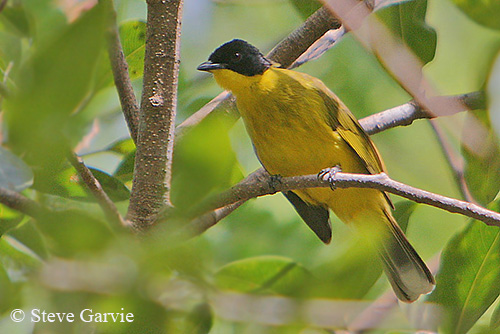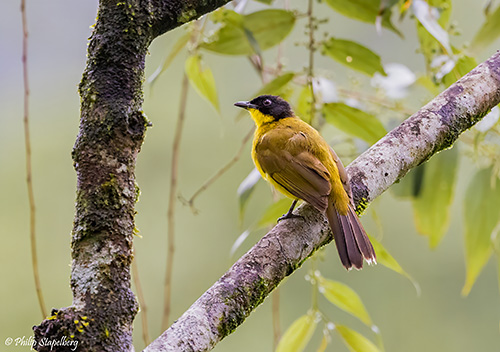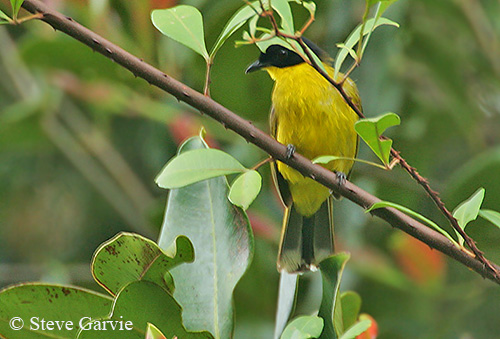
PROTECTION / THREATS / STATUS:
The Black-capped Bulbul is described as generally common and one of the commonest species in Sri Lanka, especially through forests and well wooded habitats.
It is also present in several protected reserves and national parks, but it is rare in the dry zone.
The species does not face imminent threats to its survival, although the population is slowly declining.
But currently, the Black-capped Bulbul is evaluated as Least Concern.
Fr: Bulbul à tête noire
Ang: Black-capped Bulbul
All: Kappenbülbül
Esp: Bulbul Carinegro
Ita: Bulbul crestanera
Nd: Ceylongoudborstbuulbuul
Sd: ceylonbulbyl
Photographers:
Steve Garvie
RAINBIRDER Photo galleries
Philip Stapelberg
GALLERY
Text by Nicole Bouglouan
Sources:
HANDBOOK OF THE BIRDS OF THE WORLD Vol 10 by Josep del Hoyo-Andrew Elliott-David Christie - Lynx Edicions - ISBN: 8487334725
Wikipedia, the free encyclopaedia
Black-capped Bulbul
Rubigula melanictera
Passeriformes Order – Pycnonotidae Family
INTRODUCTION:
The Black-capped Bulbul was formerly included in the genus Pycnonotus, but following several studies of the bulbul family in 2017, this species and four other bulbuls were moved to the genus Rubigula.
The Black-capped Bulbul is endemic to Sri Lanka where it frequents forests and well wooded areas in lowlands of both wet and intermediate zones, usually up to 1,200 metres of elevation.
It feeds on fruits, seeds and insects, often in pairs and sometimes in small groups of 3-4 individuals, probably family parties. Very active while searching for food, the bird can be seen moving quickly from tree to tree within its forested habitat.
This species nests in the dense foliage of shrubs or small trees where both adults build a small, flimsy, cup-shaped structure. Both parents share all the nesting duties.
The Black-capped Bulbul is described as common throughout its forested habitat, except in the dry zone. The species is not globally threatened at the moment.
DESCRIPTION OF THE BIRD:
Biometrics:
Length: 18-19 cm
The Black-capped Bulbul is a medium-sized black and yellow bird.
The adult male has dark olive-green upperparts with yellower rump. Wings and rounded tail appear browner. Both flight-feathers and rectrices show bright olive-green edges. On the tail, the outer rectrices have broad, white tips, whereas the feather tips of the central pair are narrower.
The underparts are bright yellow, but the breast shows some pale olive markings. On the underwing, the coverts are yellow but the flight-feathers are greyish. On the undertail, the rectrices are grey with broad white tips, except on the central pair where they are narrower.

On the black head, the black feathers extend to the nape and the hindneck, whereas on the face, the black ends at the level of the malar area. Chin and throat are bright yellow.
The bill is black.
The eyes are crimson-red.
Legs and feet are dark pinkish-grey to blackish.
The female resembles males, but she has deep brown eyes.
The juvenile is dark brown on mid-crown and nape. The eyes are duller than in adults.
RANGE:
The Black-capped Bulbul is endemic to Sri Lanka.
HABITAT:
The Black-capped Bulbul frequents forests, dense scrublands and well wooded habitats. It can be seen at forest edge and may also visit gardens.
It usually occurs throughout the low country and up to the mid-hills, to at least, 1,200 metres of elevation.
It is occasionally present but rare in scattered colonies in the dry zone.
CALLS AND SONGS: SOUNDS BY XENO-CANTO
The calls of the Black-capped Bulbul include a broad repertoire of sounds. The vocalizations of this species are described as a symphony of sweet, mellow, minor-key piping whistles complemented by sharper calls.
We can hear a series of short, quavering notes which are rising and falling, described as “puwit puwit puwit-wit-wit”. It also produces a subdued, guttural “prrt,prrt,prrt”. Some low, mellow, plaintive whistles are given singly or in pairs.
The song is described as a mournful three syllable song on an ascending scale.

BEHAVIOUR IN THE WILD:
The Black-capped Bulbul feeds on fruits, seeds and insects. While foraging, it frequents the lower and middle storey, and usually forages in forested areas but also at forest edge and in gardens.
It typically moves quickly from tree to tree while searching for food. It feeds on berries of various plant species and swallows them whole. Seeds are also part of the diet.
While foraging for insects, it often makes hovering sallies to catch a prey. At this moment, the bird can be seen with both rounded wings and tail entirely fanned, showing the conspicuous white tips of rectrices.
The Black-capped Bulbul is usually found in pairs but also in small groups of 3-4 individuals, probably family parties. It may forage with other bulbul species too.
The Black-capped Bulbul has two breeding periods. The courtship displays are unknown, but they are probably modest, as both mates have the same appearance. However, we can suggest that the strong contrast between the black head and the yellow body is enhanced by adapted postures while the bird is singing.
The nest is an open cup built by both adults in small sapling at forest edge. They share all the nesting duties.
The Black-capped Bulbul is resident breeder in Sri Lanka.
The flight is often undulating when the bird flies over some distance. While foraging, it performs hovering sallies.
REPRODUCTION OF THIS SPECIES:
The Black-capped Bulbul has two breeding periods, in April-May and August-September. Two broods are probably laid.
The nest is built by both adults. They can be seen carrying broad green leaves to make a platform, plastering them in place with spider webs. The structure is loosely built with roots, grass, small twigs and dead leaves. The cup is lined with fine grasses. The nest is placed 1-3 metres above the ground in small sapling, among dense foliage or in upright fork of bush.
The female lays 2-3 pinkish eggs profusely spotted with reddish-brown.
Both parents share all the nesting duties.
